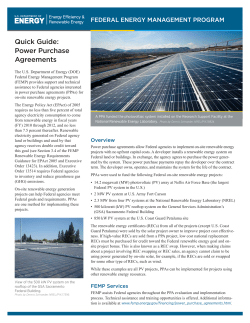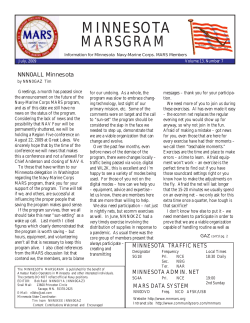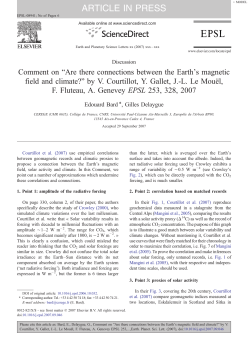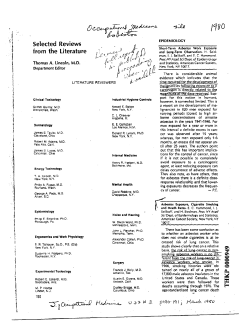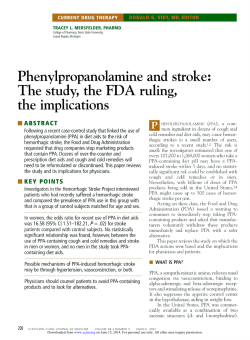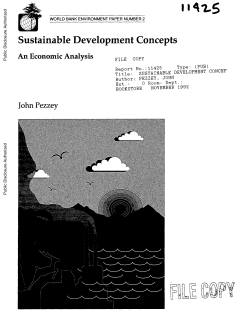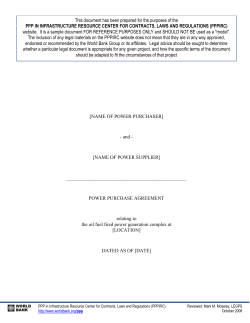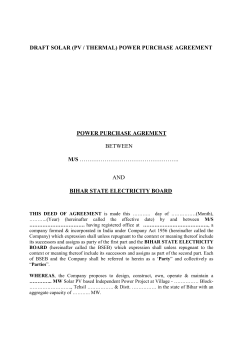
Power Purchase Agreements Chandra Shah, NREL 303-384-7557 February 2011 revised
Power Purchase Agreements Chandra Shah, NREL 303-384-7557 chandra.shah@nrel.gov Program Name or Ancillary Text February 2011 revised eere.energy.gov Overview • Customer-sited power purchase agreement (PPA) definition • Project process • Project examples • Utility Renewable Energy Services Contract (URESC) • Enhanced use lease (EUL) • PPA support, resources and key points 2 | Federal Energy Management Program eere.energy.gov Customer-Sited Power Purchase Agreement • Private entity purchases, installs, owns, operates and maintains customer-sited renewable equipment • Site purchases electricity through power purchase agreement (PPA) • Pros – – – – – – Renewable developer (or partner) eligible for tax incentives, accelerated depreciation No agency up-front capital required Renewable developer provides O&M Minimal risk to government Known long term electricity price for portion of site load On-site projects are encouraged for meeting federal renewable goal and are eligible for double bonus • Good alternative to purchasing renewable energy certificates (RECs) – Can help with energy security goals • Cons – Transaction costs – Fairly limited federal sector experience 3 | Federal Energy Management Program eere.energy.gov PPA Diagram (or other for REC sale) Federal Agency DLA Energy1, Western2 or Other Contracting Agent RECs Western: IA DLA: MOA or Support Agreement REC Payment Interconnection /Net Metering Agreement Utility PPA Power Payment($) Electricity (MWh) (and Possible InKind Consideration or Lease Payment) Renewable Developer Power Payment ($) Federal tax and other incentives Excess Electricity (if any) Utility or other Excess Electricity Purchaser 1Formerly Defense Energy Support Center (DESC) 2Western = Western Area Power Administration 4 | Federal Energy Management Program eere.energy.gov Contracts/Agreements Associated with PPA Projects • PPA: Federal agency, DLA Energy (formerly DESC) or Western Area Power Administration (Western), and Renewable Developer • Land Use Agreement: Federal agency and Renewable Developer • Interconnection/Net Metering Agreement: Utility and Renewable Developer (and/or federal agency) Possible Additional Agreements • Interagency Agreement (IA): Western and federal agency • Support Agreement or MOA: DLA Energy and federal agency • REC Contract: Renewable Developer and Utility (or other REC purchaser) • Excess Electricity Contract: Developer and Power Purchaser 5 | Federal Energy Management Program eere.energy.gov PPA Project Process Guidelines* • Step 1: Go/No Go Considerations • Step 2a: Gather utility bill information/research incentives and local market • Step 2b: Renewable screening/feasibility study/business case analysis • Step 3a: Form team and develop a plan • Step 3b: Select contracting methodology • Step 3c: Address key issues • Step 3d: High level approval • Step 4: Procurement • Step 5: Project construction, publicity and operation *These are guidelines only. Steps may be done concurrently or in a different order. It is assumed that the renewable project(s) has been selected and that evaluation of contracting options has already occurred with selection of the PPA option. Contact FEMP for assistance. 6 | Federal Energy Management Program eere.energy.gov Step 1: Go/No Go Considerations • PPA legality and Public Utility Commission oversight – Is the PPA model legal in the state? See http://www.dsireusa.org/summarymaps/index.cfm?ee=1&RE=1 – Does your utility allow PPAs (especially important for public utilities that have their own governing structure)? – Is the renewable developer subject to Commission oversight? – Are there Commission approval requirements (for REC sale or other)? – 40 USC 591: Electricity purchases must abide by state law • Who owns the land and/or building(s)? Is there a management company involved? – Who pays the utility bill? – If your agency does not own the land/buildings, do you have the owners approval? – Who will sign the contract(s)? • Future site plans – is there any chance of building/site shut-down? 7 | Federal Energy Management Program eere.energy.gov PPA Policies 3 rd -P arty Solar P V P ow er P urchase Agreem ents (P P As) www.dsireusa.org / January 2011 UT: limited to certain sectors AZ: limited to certain sectors At least 19 states + PR authorize or allow 3rd-party solar PV PPAs Authorized by state or otherwise currently in use Apparently disallowed by state or otherwise restricted by legal barriers Status unclear or unknown Puerto Rico Note: This map is intended to serve as an unofficial guide; it does not constitute legal advice. Seek qualified legal expertise before making binding financial decisions related to a 3rd-party PPA. See following slide for authority references. 8 | Federal Energy Management Program eere.energy.gov Authority/References for 3rd-Party Solar PPAs Note: Authorization for 3rd-party solar PV PPAs usually lies in the definition of a “utility” in state statutes, regulations or case law; in state regulatory commission decisions or orders; and/or in rules and guidelines for state incentive programs. This information is provided as a public service and does not constitute legal advice. Seek qualified legal expertise before making binding financial decisions related to a 3rd-party PPA. These slides will be updated quarterly. Please send comments to Amanda Vanega at amanda_vanega@ncsu.edu. • • • • • • • • • • • • • • • • • • • • Arizona: ACC Decision 71795, Docket E-20690A-09-0346 California: Cal. Pub. Util. Code § 218, § 2868 Colorado: S.B. 09-051; PUC Decision C09-0990 Connecticut: Connecticut Clean Energy Fund Delaware: S.B. 266 and S.B. 267 (2010) Hawaii: PUC Order 20633 Illinois: 220 ILCS 5/16-102; 83 Ill. Adm. Code, Part 465 Massachusetts: 220 CMR 18.00 Maryland: H.B. 1057 (2009) Michigan: 2008 Public Act 286; PSC Order Docket U-15787 New Jersey: N.J. Stat. 48:3-51; N.J.A.C. §14:8-4.1 et seq. New Mexico: H.B. 181 and S.B. 190 (2010) (effective 1/1/2011) Nevada: S.B. 395 (2009); PUC Orders 07-06024 and 07-06027 New York: NYCLS 2.13 Ohio: PUC Order 06-653-EL-ORD Oregon: PUC Order, Docket 08-388 Pennsylvania: PUC Order, Docket M-00051865 Puerto Rico: No policy reference available; based on news reports and articles Utah: H.B. 0145 (2010) (effective 3/31/2010, and limited to installations at public buildings, schools or 501(c)(3) non-profits) Virginia: VA Code § 56-232 and 20VAC5-315-20 DSIRE acknowledges IREC and Keyes & Fox, LLP, for their support in creating and maintaining this resource. 9 | Federal Energy Management Program eere.energy.gov Step 2: Gather information • Gather utility bills and other applicable information such as submeter data, utility tariff information (peak/non-peak, TOU, seasonal rates; demand charge), competitive electric supply contract information (if applicable), etc. – Will the project impact rates? – Are there applicable standby charges or other pertinent utility policies that will impact the utility bill? • Compare energy usage information to renewable generation (project will be simpler if the site will use all of the electricity) • Research renewable energy certificate (REC) markets, applicable incentives (rebates, tax incentives, etc) and renewable policies (net metering, feed-in tariff, community solar, etc.) – See http://www.dsireusa.org/ • Renewable screening, feasibility study and/or business case analysis 10 | Federal Energy Management Program eere.energy.gov RPS Policies with Solar/DG Provisions R P S P olicies w ith Solar/ DG P rovisions www.dsireusa.org / February 2011 WA: double credit for DG NH: 0.3% solarelectric x 2014 OR: 20 MW solar PV x 2020; MI: triple credit for solar- double credit for PV NV: 1.5% solar x 2025; 2.4 - 2.45 multiplier for PV MA: 400 MW PV x 2020 NY: 0.4788% customer- electric CO: 3.0% DG x 2020 1.5% customer-sited x 2020 IL: 1.5% PV x 2025 MO: 0.3% solarelectric x 2021 AZ: 4.5% DG x 2025 NJ: 5,316 GWh solar- electric x 2025 UT: 2.4 m ultiplier for solar-electric sited x 2015 OH: 0.5% solar- NM: 4% solar-electric x 2020 electric x 2026 W V: various m ultipliers NC: 0.2% solar x 2018 0.6% DG x 2020 DC PA: 0.5% PV x 2021 DE: 3.5% PV x 2026; triple credit for PV MD: 2% solar-electric x 2022 DC: 0.4% solar x 2020 TX: double credit for non-wind (non-wind goal: 500 MW) Renewable portfolio standard with solar / distributed generation (DG) provision Renewable portfolio goal with solar / distributed generation provision Solar water heating counts toward solar provision 11 | Federal Energy Management Program 16 states + DC have an RPS with solar/DG provisions eere.energy.gov Net Metering Net M etering www.dsireusa.org / February 2011 WA: 100 MT: 50* ND: 100* OR: 25/2,000* WI: 20* NE: 25 NV: 1,000* UT: 25/2,000* CO: no limit IL: 40* MO: 100 KY: 30* NM: 80,000* AR: 25/300 NJ: no limit* DC DE: 25/100/2,000 co-ops & munis: 25/100/500 MD: 2,000 WV: 25/50/500/2,000 GA: 10/100 FL: 2,000* HI: 100 * PA: 50/3,000/5,000* DC: 1,000 LA: 25/300 AK: 25* State policy VA: 20/500* NC: 1,000* OK: 100* AZ: no limit* CT: 2,000* NY: 10/25/500/2,000* OH: no limit* IN: 10* KS: 25/200* RI: 1,650/2,250/3,500* MI: 150* IA: 500* co-ops & munis: 10/25 VT: 20/250/2,200 NH: 100 MA: 60/1,000/2,000/10,000* MN: 40 WY: 25* CA: 1,000* ME: 660 co-ops & munis: 100 KIUC: 50 Voluntary utility program(s) only PR: 25/1,000 43 states + DC & PR have adopted a net metering policy State policy applies to certain utility types only (e.g., investor-owned utilities) Note: Numbers indicate individual system capacity limit in kW. Some limits vary by customer type, technology and/or application. Other limits might also apply. This map generally does not address statutory changes until administrative rules have been adopted to implement such changes. 12 | Federal Energy Management Program eere.energy.gov Step 3a: Form team and develop plan • Form project team – *champion*, decision-maker, energy manager, facilities, contracting officer, attorney, renewable expert, electrical engineer, budget, real estate, environmental, sustainability, safety, other • Determine if there are non-federal stakeholders (other than the utility) that will have an interest in the project • Investigate and fully understand approval process – Discuss when to get upper management buy-in • Establish roles and responsibilities • Develop a timeline • Schedule periodic meetings to keep project on track 13 | Federal Energy Management Program eere.energy.gov Step 3b: Select contracting methodology • Site or other agency contracting staff • DLA Energy (formerly Defense Energy Support Center) Renewable Team lead by: – Andrea Kincaid, DLA Energy - andrea.kincaid@dla.mil, 703-7678669 – John Nelson, DLA Energy - john.nelson@dla.mil, 703-767-8523 – https://www.desc.dla.mil/DCM/DCMPage.asp?pageid=589 • Western Area Power Administration (Western) – Federal sites in Western’s service territory only – Western negotiates and signs the PPA contract once renewable developer is selected by the federal site – Federal site must determine process for renewable developer selection 14 | Federal Energy Management Program eere.energy.gov Step 3c: Address key issues Contract Length • PPA contract length - Long term best (at least 10 years, preferably 20) – FAR Part 41 Utility Services (10 year authority) • GSA authority, requires delegation for use (some agencies have permanent delegation) – FAR Part 12 Acquisition of Commercial Items (5 year authority) – Best to start contract when electricity starts flowing, so that the construction period is not included towards contract length limitation • Long term contract options – DOD 10 USC 2922A – 30 year authority, requires Secretary of Defense approval (may be delegated to lower level) – Use Western Area Power Administration 15 | Federal Energy Management Program eere.energy.gov Step 3c: Address key issues Contract Length • Western Area Power Administration (Western) Option – Long term contract authority - at least 20 years – Western can sign PPAs for Federal agencies in their service territory – Site selects renewable developer and brings to Western – Examples: NREL, Fort Carson – Nominal fee for Western’s services – Renewable Resources for Federal Agencies (RRFA) program Randy Manion, (720) 962-7423, manion@wapa.gov http://www.wapa.gov/powerm/pmtags.htm (See program brochure at bottom of web site) 16 | Federal Energy Management Program eere.energy.gov Step 3c: Address key issues Contract Length • Additional long term contract options – DFARS Procedures, Guidance and Information (PGI) 241.2 Acquiring Utility Services* – Long term land use agreement, with developer giving federal agency right of first refusal to purchase power at a pre-determined price – FAR Part 41 ten year contract with 10 year option • Must be “true” option, requiring: 1) No assumption that the option will be exercised and 2) No penalties if the option is not exercised. • Could be combined with long term land use agreement – Congressional proposals for long term renewable contracting authority – ESPC Energy Services Agreement (see PPA Hybrid Options) *Used for Nellis AFB indefinite term PPA contract, with one year termination notice http://farsite.hill.af.mil/reghtml/regs/far2afmcfars/fardfars/dfars/PGI%20241_2.htm#TopOfPage 17 | Federal Energy Management Program eere.energy.gov Step 3c: Address key issues Utility Coordination • Coordinate with the local utility – VERY important to notify the utility early on in project development – Interconnection considerations: application, cost and study requirements; queue and timeframe, agreement terms & conditions – Utility bill impacts: possible tariff change, standby charges, etc. – Renewable system tie-in options • What is acceptable to the utility? • Does the site own their electrical lines or are they privatized? • If site does not own the electrical lines, the renewable developer may have to build separate lines • Will the utility allow interconnection on the utility side of the meter or does interconnection have to be on the customer side of the meter? – Net Metering rules • How do they measure renewable project capacity for net metering limit purposes (ex. ac, dc, based on inverter capacity)? – Other applicable policies (feed-in tariff, Community Solar, etc) 18 | Federal Energy Management Program eere.energy.gov Step 3c: Address key issues Environmental • Investigate National Environmental Policy Act (NEPA), Endangered Species Act (ESA), National Historic Preservation Act (NHPA), and other applicable federal/state/local environmental and permitting requirements – Crucial to investigate requirements early in process and get required environmental studies started as soon as possible – Draft solar Programmatic Environmental Impact Statement for 6 Southwestern States (http://solareis.anl.gov) • Open for comments until March 17, 2011 – DOE NEPA Implementing Procedures (10 CFR Part 1021), B5.1 Categorical Exclusions Applicable to Conservation, Fossil, and Renewable Energy Activities http://nepa.energy.gov/documents/nepa1021_rev.pdf (p.26-27) 19 | Federal Energy Management Program eere.energy.gov Step 3c: Address key issues Environmental • Stormwater management – EISA Section 438 and other local requirements • EPA Rule to control discharge of pollutants from construction sites (erosion and sediment control measure requirements) http://www.epa.gov/waterscience/guide/construction/ • Water availability (for most concentrated solar power and biomass) – May need to consider dry or hybrid cooling options 20 | Federal Energy Management Program eere.energy.gov Step 3c: Address key issues Land Use Agreement • Determine if a separate land use agreement (LUA) is required – If yes, explore the best option for your site: lease, easement, license, right-of-way, other – Agreement will likely include site access, security, environment, safety, and/or health provisions. If an LUA is not required these provisions can be included in the PPA – Investigate options and approval requirements early in process – Contract length limitations are likely (agency authorities vary) • Include construction and decommissioning period within total LUA contract length – Long term land use agreement can help project viability if PPA has a short term contract length 21 | Federal Energy Management Program eere.energy.gov Step 3c: Address key issues Land Use Agreement • Land use agreement resources – GSA revocable license, Form 1582 available at http://www.gsa.gov/Portal/gsa/ep/formslibrary.do?viewType=DET AIL&formId=171CF1BCDA983EA985256AA2004B7297 – GAO Redbook, Volume 4, Chapter 16 http://www.gao.gov/special.pubs/d01179sp.pdf – Army Regulation 405.80 • Possible requirements – Land appraisal and/or legal survey – Environmental baseline study (to document conditions that must be met at end of contract if system removal and restoration is required) 22 | Federal Energy Management Program eere.energy.gov Step 3c: Address key issues RECs • Renewable energy certificate (REC) ownership – RECs represent the environmental attributes of electricity produced from renewable sources – Ensure that PPA contract explicitly spells out REC ownership – If valuable RECs (usually solar) are sold, then must use “REC swap” option for credit towards EPACT 2005 renewable goal and on-site double bonus • REC Swap: sell valuable RECs, purchase cheaper national RECs • Federal Renewable Guidance http://www1.eere.energy.gov/femp/pdfs/epact05_fedrenewenergyguid.pdf • Best to retain RECs unless expected price is much higher than national REC price – No credit towards EO13514 greenhouse gas reduction goals if RECs are sold – Federal Trade Commission Proposed Revised Guidelines • Be careful how project is portrayed if RECs are sold 23 | Federal Energy Management Program eere.energy.gov Step 3c: Address key issues Project Specific Considerations • Roof PV Systems – Roof information • Type • Age and roof replacement plans (new roofs are ideal) • Maximum load the roof can safely support (taking into account rain/snow and likely accumulation locations) • Has a roof structural analysis been completed? – – – – – – Roof orientation Roof warranty Avoid shading (applies to all solar project types) Locate roof obstructions such as HVAC equipment, vents, etc. Potential roof leaks: may want to limit or prohibit roof penetrations Fire protection: GSA and certain states such as California have setback requirements and other guidelines 24 | Federal Energy Management Program eere.energy.gov Step 3c: Address key issues Project Specific Considerations • Ground-Mounted PV Systems – Land requirements vary depending on PV type and efficiency (crystalline vs. thin film) and system type (fixed vs. tracking) – Soil conditions – Land slope and direction • Carport PV Systems • What is the available space (taking into account trees, grassy areas, etc.)? • Height requirements • Lighting • Storm water drainage requirements • Snow melt from the carport may refreeze. Consider using water resistant pavement and/or improve drainage by adding gutters 25 | Federal Energy Management Program eere.energy.gov Step 3c: Address key issues Project Specific Considerations • Concentrated Solar Power (CSP) Projects – Is the available land flat enough? If not, is ground leveling acceptable? – Is there available water for cooling? At what cost? (Dry or hybrid cooling may need to be considered.) • Wind Projects – Are there radar issues? – Are there height concerns? – Has FAA been notified, especially if the site is close to an airport/flight path? – Do you have wind data? 26 | Federal Energy Management Program eere.energy.gov Step 3c: Address key issues Project Specific Considerations • Biomass Projects – – – – – – – – What type of fuel and combustion technology will be used? Will electricity and/or heat be used? What is the fuel source and distance from federal site? What is the cost of the fuel? Can a long term contract with a known price be secured? What are the fuel delivery plans and frequency (truckloads/day) What are fuel storage plans? What are the state/local emission regulations, permitting and other applicable environmental requirements? Is there available water for cooling? At what cost? (Dry or hybrid cooling may need to be considered.) 27 | Federal Energy Management Program eere.energy.gov Step 3c: Address key issues Project Specific Considerations • Road, fence and other requirements • Determine who will incur cost • Wind standards • Electrical considerations – Who owns the site electric lines? Review privatization contract if applicable. – Gather electrical drawings and other pertinent site information – Tie-in options (best to choose renewable project size/location that is compatible with the site electrical system) – Any expected electrical upgrades required? – Inverter location options – Is your site tied to a network distribution system? • See report for solutions: http://www.nrel.gov/docs/fy09osti/45061.pdf – Include drawings and other information as part of RFP package 28 | Federal Energy Management Program eere.energy.gov Step 3d: High level approval • Understand all approval requirements – Some agencies require high level/headquarters approval – Incorporate expected approval time requirements into project plan • Ensure that all necessary approvals are completed before moving forward • Possible approval considerations – – – – – Project location Compatibility with mission Future site infrastructure plans Contracting vehicle and methodology rationale Other 29 | Federal Energy Management Program eere.energy.gov Step 4: Procurement • Optional step - Request for Information (RFI) • Develop Request for Proposal (RFP), “Opportunity Notice,” or other procurement document – Renewable specifications: • Renewable project type and location(s) • Renewable developer’s responsibility for all O&M/repair and replacement (ensure there are no hidden costs such as inverter replacement) – Infrastructure requirements: roads, fence, electrical upgrades, etc. – Termination provisions – Proposal evaluation methodology options: best value, low price/technically acceptable (LPTA), low price – Evaluation criteria and submittal requirements, including financial capability 30 | Federal Energy Management Program eere.energy.gov Step 4: Procurement • Develop RFP/procurement document cont’ – Allowable PPA Electricity Price Format • • • • Fixed price (easiest to evaluate) Escalation factor (usually 1-3%) Other options such as de-escalation factor or tied to utility rate No restrictions – End of contract options • System removal (with wear and tear accepted or with requirement to restore land and/or building to original condition). • System purchase at fair market value to meet IRS guidelines for tax incentive eligibility • Issue a new solicitation for a follow-on contract • Other – Metering requirements • Ensure compatibility with energy management system , site or agency metering protocol, REC purchaser and/or other applicable requirements • Real-time access to generation information 31 | Federal Energy Management Program eere.energy.gov PV Output Metering Example 32 | Federal Energy Management Program eere.energy.gov Step 4: Procurement • Issue RFP and distribute widely – FedBizOpps – Green Power Network (http://apps3.eere.energy.gov/greenpower/financial/) – Applicable renewable industry association (SEIA, AWEA, etc) – Other • Site visit, tour and pre-proposal meeting – Review solicitation and answer questions – Tour potential renewable project location(s) and pertinent electric infrastructure – Considerations • Access requirements • Safety plan (especially if roofs involved) • Method to ensure everyone has access to the same information (especially for Q&A during site tour) 33 | Federal Energy Management Program eere.energy.gov Step 4: Procurement • Proposal Evaluation – Evaluate price and escalation factors carefully – Consider other potential electric bill changes: • • • • Standby charges Possible utility tariff changes Impacts due to time-of-use, peak/non-peak and/or seasonal rates Demand charge savings (keep in mind that these savings will be minimal) – Compare price proposals to NIST/EIA rates and/or other rate forecast “Energy Price Indices and Discount Factors for Life-Cycle Cost Analysis - May 2009, Annual Supplement to Handbook 135” (http://www1.eere.energy.gov/femp/pdfs/ashb09.pdf) 34 | Federal Energy Management Program eere.energy.gov Step 5: Project construction, publicity and operation • Project construction – Coordinate with renewable developer to ensure that crucial deadlines are met, such as those associated with REC purchase and/or incentives – Assist with interconnection studies, interconnection/net metering contract negotiations, rebate/incentive applications and other applicable requirements – Single site point of contact helpful • Publicity – Be careful what you say if RECs are not retained by the site. Consider new proposed Federal Trade Commission Green Guide revisions • http://www.ftc.gov/bcp/edu/microsites/energy/about_guides.shtml • http://www.ftc.gov/os/fedreg/2010/october/101006greenguidesfrn.pdf (p.169 of pdf) – – – – • Press conference Press release Web site stories (FEMP or other) FEMP Focus stories Operation – Track actual production for annual reporting and to ensure system operation – Purchase replacement RECs if necessary 35 | Federal Energy Management Program eere.energy.gov Other Information & Considerations • Ensure building lease provisions allow for solar and other renewables • Include solar-ready specifications for new buildings/roofs – NREL report “Solar Ready Buildings Planning Guide” http://www.nrel.gov/docs/fy10osti/46078.pdf • Community Solar/Virtual Net Metering/Solar Gardens • Template PPA tool kit documents in development – Template RFP – List of questions to ask – Other 36 | Federal Energy Management Program eere.energy.gov Example Federal PPA Projects 37 | Federal Energy Management Program eere.energy.gov Nellis AFB PV Project in NV • • • • • • • • • 14.2 MW single axis ground mounted PV on 140 acres including closed landfill PPA price – 2.2¢/kwh Estimated first year electricity savings = $1 million, after standby charges RECs sold to Nevada Power (for state RPS solar set-aside) FAR Part 41 utility service contract Indefinite term with one year termination notice (using FAR Part 41 PGI)* 20-year ground lease Ribbon cutting event December 2007 Performance Monitoring web site http://mypowerlight.com/Commercial/kios k.aspx?id=1dd14d57-7840-4b2d-af0a0fe0fdd5c872 *http://farsite.hill.af.mil/reghtml/regs/far2afmcfars/fardfars/ dfars/PGI%20241_2.htm#TopOfPage 38 | Federal Energy Management Program eere.energy.gov NREL PV Project in CO • • • • • • • 720 kW (1200 MWh) single-axis tracking, ~ 5 acres 20-year PPA contract (utilizing Western) 20-year easement RECs sold to Xcel Energy for RPS solar set-aside (20 year contract) PPA price competitive with utility electricity price forecasts (based on EIA projections) at time contract was signed Operational December 2008 Additional PV projects – 1083 kW ground-mounted system – 449 kW and 94 kW roof-top systems 39 | Federal Energy Management Program eere.energy.gov Fort Carson PV Project in CO • 2 MW, 3200 MWh in first year (~2% of Ft. Carson’s load) • Fixed, non-escalating energy rate • 17-year contract, with 3 year option (utilizing Western) • No cost 20 year lease (using 10 USC 2667 lease authority) • RECs sold to Xcel Energy (20 year contract) • Ground-mounted, fixed system covering 12 acre former landfill • First Solar thin film, 25 year warranty • Came on-line December 2007 40 | Federal Energy Management Program eere.energy.gov GSA Sacramento PV Project in CA • .5 MW roof-top PV (thin film) • 10-year contract • Price matched to utility energy rate, with price floor • Utility rebate and federal incentives (30% tax credit & accelerated depreciation) - pay for approximately 1/2 cost • License for use of roof • Renewable developer retains RECs • Came on-line March 2008 41 | Federal Energy Management Program eere.energy.gov USCG Petaluma PV Project in CA • 855 kW ground-mounted, fixed PV on slightly less than 4 acres • PPA price is 13¢/kWh in the first year, with 3.5% annual escalation • One year contract with 24 one year renewal options • Irrevocable 25 year license • Developer receives 22¢/kWh California Solar Initiative (CSI) performance based incentive (PBI) payments for first 5 years • Site retains RECs • Came on-line April 2010 42 | Federal Energy Management Program eere.energy.gov Project Comparison Nellis AFB, NV Fort Carson, CO NREL, CO GSA Sacramento, CA Size 14.2 MW, 140 acres including closed landfill 2 MW on 12 acre closed landfill 2.3 MW total .5 MW 855 kW on ~4 acres Type Ground Mounted, Single Axis Tracking PV Ground Mounted, Fixed PV Two Ground Mounted, Single Axis Tracking systems & two rooftop PV systems Roof-top PV Ground Mounted, Fixed PV PPA Contract Length Indefinite with 1 year termination 17 with 3 yr option 20 years 10 years 1 yr with 24, 1 yr options Land Use Agreement Lease (20 yrs) Lease (20 yrs) Easement for ground systems, license for roof systems (20 yrs) License (10 yrs, included in PPA) Irrevocable License (25 years) Procurement and Contracting Agent Site Site, in partnership with Western Site, in partnership with Western Site Site Sold to utility Sold to utility Sold to utility Retained by renewable developer Transferred to site RECs 43 | Federal Energy Management Program USCG Petaluma, CA eere.energy.gov URESC 44 | Federal Energy Management Program eere.energy.gov Utility Renewable Energy Services Contract (URESC) • Utility Renewable Energy Services Contract (URESC) – PPA with utility – Contract with serving utility for the purchase of electricity from utility owned, utility operated on-site renewable generation – Utility/renewable partner own renewable project and take advantage of tax benefits – FAR Part 41.501c4 (FAR 52.241-5 Contractor’s Facilities) may apply – Public Utility Commission approval may be required – Draft template agreement developed through Energy Lawyers and Contracting Officer Working Group – Several projects in progress – Pursuing other URESC projects 45 | Federal Energy Management Program eere.energy.gov Enhanced Use Lease (EUL) 46 | Federal Energy Management Program eere.energy.gov Enhanced Use Lease (EUL) • Only certain agencies have an EUL authority • EUL is a real estate agreement • The lease is competed (rather than the energy purchase, as in a PPA) • Payment or in-kind consideration • Usually for large projects where project size > site load • GovEnergy 2010 presentations http://www.govenergy.com/2010/Workshop/SessionsByTrack/Track_Financing.aspx (Session 5) http://www.govenergy.com/2010/Workshop/SessionsByTrack/Track_Contracting.aspx (Session 3) • GovEnergy 2009 presentations http://www.govenergy.com/2009/presentations.html#finance (Session 5) http://www.govenergy.com/2009/pdfs/presentations/Energy101-Session03/Energy101-Session03Burke_Kim.pdf • GovEnergy 2008 presentations (Session 5) http://www.govenergy.com/2008/presentations2008.html#finance 47 | Federal Energy Management Program eere.energy.gov Fort Irwin EUL • Notice of Opportunity to Lease • Up to 1000 MW at 5 Fort Irwin sites • In-kind services equal to or greater than fair market value of land • Developer selection made July 20, 2009 – Clark-Acciona Team – First phase: Up to 315 MW solar thermal/PV by 2016 • http://eul.army.mil/ftirwin/ 48 | Federal Energy Management Program eere.energy.gov NASA Kennedy Space Center and FP&L EUL • • • • • • • • Partnership between NASA and Florida Power & Light EUL signed June 2008 Phase 1 involves 60 acres, potential phase 2 for additional 40 acres 10 MW FPL-owned PV project – Output feeds into FPL transmission system – Substation expansion required In-Kind Consideration - 990 kW NASA-owned PV – FPL construction – Output feeds into NASA-owned distribution system 130 mph wind standard Both systems operational See http://www.fpl.com/environment/solar/spacecoast.shtml 49 | Federal Energy Management Program eere.energy.gov PPA Support/Resources & Key Points 50 | Federal Energy Management Program eere.energy.gov Key Points • Ensure that the PPA option is allowed • Contact your serving utility early on for interconnection agreement and study requirements/timeframe/cost and other project considerations (net metering, tariff implications, standby charges, etc) • Research applicable incentives and policies (http://www.dsireusa.org/) • Review contract length options • Determine NEPA and other environmental/permitting requirements and start the process early • Discuss land use agreement options, approval process and develop draft agreement • Consider renewable tie-in options (taking into account utility metering for your site) 51 | Federal Energy Management Program eere.energy.gov PPA Support • Renewable screening to identify cost effective renewable projects – Provide basic information using form available at http://www.eere.energy.gov/femp/financing/espcs_techplanning.html • Limited funding available for detailed feasibility studies • Assistance throughout PPA project process, such as: – Market research • Applicable incentives and/or solar REC market • Net metering and other applicable policies • Possible utility bill impacts (tariff/competitive electric supply changes, standby charges, etc.) • Interconnection requirements – – – – Land use agreement NEPA Solicitation provisions Proposal evaluation 52 | Federal Energy Management Program eere.energy.gov Resources • Chandra Shah, National Renewable Energy Laboratory (NREL) chandra.shah@nrel.gov, 303-384-7557 • Gerald Robinson, Lawrence Berkeley National Laboratory (LBNL) gtrobinson@lbl.gov, 510-486-5769 • Mike Warwick, Pacific Northwest National Laboratory (PNNL) mike.warwick@pnl.gov, 503-417-7555 (for DOD sites) • Andrea Kincaid, DLA Energy andrea.kincaid@dla.mil, 703-767-8669 • John Nelson, DLA Energy john.nelson@dla.mil, 703-767-8523 • Randy Manion, Western manion@wapa.gov, 720-962-7423 • FEMP PPA Web Site: http://www.eere.energy.gov/femp/financing/power_purchase_agreements.html – PPA Quick Guide http://www1.eere.energy.gov/femp/pdfs/ppa_guide.pdf – PPA Presentation (updated on periodic basis) – Sample Documents 53 | Federal Energy Management Program eere.energy.gov FEMP PPA Web Site 54 | Federal Energy Management Program eere.energy.gov FEMP PPA Web Site 55 | Federal Energy Management Program eere.energy.gov Resources • Alternative Financing Options June 2010 webinar recording (covering PPA, UESC, ESPC) http://apps1.eere.energy.gov/femp/training/course_detail_ondemand.cfm/CourseId=44 • “Procuring Solar Energy: A Guide for Federal Facility Decision Makers” http://www1.eere.energy.gov/solar/federal_guide/ • FEMP Focus article (Fall 2007, p. 16-17) http://www1.eere.energy.gov/femp/news/fempfocus.html – • EPA Solar PPA web site and 7/28/09 webinar (for all sectors, not just federal) http://www.epa.gov/greenpower/buygp/solarpower.htm http://www.epa.gov/greenpower/events/july28_webinar.htm • • FEMP Focus article with updated information planned for FY2011 NREL report “Solar Ready Buildings Planning Guide” (solar-ready specifications for new buildings/roofs) http://www.nrel.gov/docs/fy10osti/46078.pdf Solar Today article: “Solar Energy with No Money Down” by Jason Keyes, Joseph Wiedman, Christopher Cook and Tucker Cottingham (September/October 2010, p.44) http://www.solartoday-digital.org/solartoday/20100809#pg44 56 | Federal Energy Management Program eere.energy.gov
© Copyright 2025
